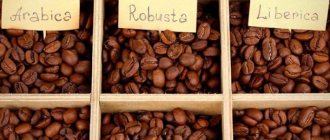- Coffee varieties: varieties and characteristics
- By type of coffee beans
- By grinding degree
- Classification of coffee varieties
- The best coffees
- Elite coffees
- Exotic coffees
- Coffee production
Coffee is an invigorating, tonic strong drink made from the fruits of the coffee tree. The first samples of this drink belong to ancient monks who found wild berries on one of the bushes. Over time, the monks noticed that brewed coffee beans helped eliminate drowsiness, which was attractive for night prayers.
What is a coffee drink? This is a large number of different ingredients added to classic black coffee that create amazing cocktails for every taste. In the modern world, everyone can try absolutely any type - natural espresso or aromatic latte, a less strong Americano or a delightfully aromatic lungo.
Coffee varieties: varieties and characteristics
The list of popular blends includes more than 50 items, but they are based on only three varieties: Robusta, Arabica, Liberica. One blend of coffee beans may contain pure Arabica from different cultivation regions, additions of strong Robusta, or a small percentage of aromatic Liberica. Read more about growing methods and characteristics here.
Taste and aroma properties may vary depending on climatic conditions, roasting methods, and types of grain.
Fans of Brazilian beans should be aware of the country's unique roasting practices, where roasters add cloves (or cinnamon) to create a deeper flavor. Produce grown in iodine-rich soils will have a spicy flavor.
The most common coffee variety is Arabica Australia Skyberry from Australia. Arabica beans are known and in demand all over the world; gourmets appreciate its deep aroma with a pronounced sour taste.
The mocha variety from Yemen deserves special attention. It is these lands that are considered the first distributors of grains. Next we will talk about how many types of coffee there are, their cost and what roasting methods there are.
By type of coffee beans
The size of the coffee beans, which are described by the manufacturer on the product packaging, takes part in determining the type of coffee. As a rule, grain sizes are divided into: large, medium and small. The smaller the grain size, the worse its quality.
The abundance of coffee drinks allows you to experiment with interesting blends of Arabica and Robusta. Natural coffee beans can be combined with almost any spices (including chili pepper), sweet additives, and fruits.
A label indicating the importing country, proportions of varieties, and roasting method will help you choose the right blend. Robusta is characterized by bitterness, while pure Arabica has a delicate creamy taste.
Aromatic bouquets and flavor shades are created by the ideal ratio of coffee varieties. Among the most popular products, fans of the strong drink highlight:
- African coffee variety Arabica Burundi AA with spicy and chocolate notes;
- Arabica Guatemala Antigua (ideal for lovers of bitterness with hints of prunes);
- spicy Brazil Santos with the inherent sourness of Arabica;
- Robusta India Cherry (bitter coffee variety, rarely consumed in its pure form, ideal with blends);
- Yemen Mocha Mattari (legendary variety, the first coffee brought to Russia).
According to geographic location, coffee varieties are labeled as follows: mountain beans SHG; very hard – SHB; flat – CS, grown on the foothills – HG, hard – HB.
By grinding degree
There is an opinion that strong natural coffee must have a bitterness. The palette of coffee flavors completely debunks this myth: most blends are created with a high Arabica content, which eliminates the bitter aftertaste even with heavy roasting.
Different types of coffee may not have the same characteristics. The aromatic drink is selected individually, taking into account your taste preferences. What type of coffee is the most delicious? Even fastidious coffee lovers will not answer this question the same way. Considering the large number of additives, you can choose an inexpensive type of coffee and enjoy interesting cocktails with the whole family. Others will think that there is no such thing as expensive bad coffee, and will spend a lot of money on their own whim.
If ground coffee is your priority, pay attention to the degree of grinding and preparation features:
| Fine grind (finegrind) | To brew coffee in a Turk (cezve), it is best to choose a fine grind. This degree of grinding is considered a classic: Turkish or Oriental coffee. The “dust” in the cup forms a large amount of suspension, so the finished coffee is perceived as thicker. Grinding time in an electric coffee grinder is 15-20 seconds. |
| Medium grind | For high-quality coffee prepared in a carob-type coffee maker, a medium grind is necessary so that the filter holes do not clog. It should be as uniform as possible. Otherwise, it will not be possible to compress such coffee in a holder; part of the powder will not participate in preparation. As a result, the coffee will not brew well. Grinding time in an electric coffee grinder is 10-13 seconds. |
| Coarse grind (coarsegrind) | To brew coffee in a drip coffee maker or French press, use coarsely ground coffee. In this case, large grains will remain in the mesh of the French press and filters of drip coffee makers, without getting into the cup. For coarse grinding (with particles up to 0.8 mm in size), the brewing time should be at least 6-8 minutes. Grinding time in an electric coffee grinder is 7-10 seconds. |
If you prefer ground coffee, do not let it boil when cooking in a Turkish coffee pot. When boiling, the grains lose their flavor bouquet and completely change their aroma.
Classification of coffee varieties
In addition to the classification of coffee varieties by region of growth, there are differences in the quality of the beans. Marking of raw materials:
- AA, A – elite variety;
- AB – good;
- BA, B – average quality;
- BB, C – low.
According to the process of preparing raw materials, products are labeled as follows: European preparation (EP) according to the European method (involves the elimination of 8 defects per 300 grams of grain), American preparation (AP) - the American method with the removal of no more than 23 defects per 300 grams.
In addition to the main three degrees of grinding, coffee varieties can be: Fine espresso grind (thin espresso for coffee makers), Pulverized (powdered) for preparing real Turkish coffee.
Varieties and brands of Ethiopian coffee
Ethiopia specializes in Arabica, which in turn is divided into three types:
- Longberry (large grains that make the most delicious drink).
- Shortberry (grows in Eastern Ethiopia, smaller grains than the previous species).
- Mocha (the beans are shaped like peas and are called peaberry; in the bouquet of the finished coffee you can feel the nuances of chocolate, spices and citrus).
Famous manufacturers
The Ethiopian coffee industry employs approximately 12 million people in one way or another. There are many small producers in the country and there are no large market monopolists, so the highest quality and delicious coffee is determined not so much by brands, but by region of origin.
Popular brands of Ethiopian coffee: FTO Ethiopian Yirgacheffe Coffee, Ethiopian Sidamo Guji Natural Coffee, Equal Exchange Organic Coffee, Peet's Coffee, Garden of Coffee, etc.
The best coffees
Popular varieties include not only elite coffee varieties. Different methods of growing, cooking, and roasting lead to the appearance of completely new flavors. All types of blends are created in special laboratories with quality control.
The best varieties include:
- Colombian - grows on the mountain slopes of the Andes, which have the ideal humidity and amount of sunlight for the plant;
- Ethiopian coffee, where the daily harvest reaches 240 thousand tons (the country provides approximately 30% of the world's Arabica trade turnover);
- Brazilian, which brings in most of the country's income;
- Indian, ranking sixth in the ranking of world production (more than 400 thousand hectares are occupied by coffee plantations);
- Indonesian, Mexican, Yemeni species.
The list gives a rough idea of the countries that make up the majority of the coffee market. However, real coffee lovers are sure: lesser-known brands from Kenya, Tanzania, Uganda and other countries also supply products of decent quality.
What are the different types of coffee based on roast level? There are three main methods: light, medium, dark (strong). But on the packaging you can find a description of the product with the name “Venetian” or “Italian” roasting. In the latter case, the shade of the grains changes almost to black, with it you will get a strong, thick drink (cooking with cream or milk is recommended).
Elite coffees
High-quality coffee beans cannot be cheap - true admirers of natural drinks know this. The market has formed a rating of the best manufacturers who care about the high quality of all types of grains and packaging for their storage:
- large Arabica Maragogype from South America (also grown in Nicaragua and Mexico);
- Guatemala Lagos Shb is spicy in taste with an interesting smoky aroma;
- Bourbon Arabica El Salvador Chalatenango with a soft almond hue;
- the purest Sidamo Mocha from Ethiopia (followed by the fragrant Irgochif);
- the most expensive Kopi Luwak in the world from Yemen, processed in a specific way.
You will not find expensive (elite) types of grains on the shelves of ordinary supermarkets. They can only be ordered from catalogs or specialized online stores.
Keep in mind that to reduce the cost of these products, grain mixtures are often offered. Premium varieties are harvested and produced only in limited quantities, resulting in high prices for small supplies. To reduce the cost and increase the volume of the product, companies use blends of different coffees.
Exotic coffees
For a long time, Kopi Luwak was considered the most expensive and exotic type of coffee. The luwak grains processed in the stomach of the animal got rid of natural bitterness and acquired an interesting chocolate flavor. The aromatic variety of coffee is obtained without the involvement of breeders and the latest technologies - the animal eats only the ripe, best fruits. Price – from 400 to 1000 $/kg.
There is a cheaper version of a rare variety of coffee - Monkey Coffee, obtained by Taiwanese farmers. The technology is similar to the first type, but Formosan monkeys are used to process the grains. This significantly reduced the price to $45-50/kg. The finished drink has a pronounced vanilla flavor.
The following types of coffee are also elite:
- Jamaica Blue Mountain with unusual floral tones;
- Yellow Bourbon - a type from Brazilian plantations (differences - nutty, tobacco, woody notes);
- Old Java, aged without roasting (Indonesia);
- Kenya AA Ruiruiru with high acidity and a long, multi-faceted aftertaste (from caramel to spice flavors).
You can only buy some of the listed coffee varieties at special auctions. True gourmets assure that despite the high cost, these are exotic drinks that have no analogues.
Types of Ethiopian coffee
In total, there are more than a thousand types of coffee beans in the country. Until 1995, Ethiopia was divided into provinces, today they have been replaced by districts, but the familiar provincial names are still widely used to refer to coffee.
Many coffee farms are located in the southernmost province of Sidamo, in particular, one of the best types of coffee in the world is produced here - Yirgacheffe. The same province supplies the world market with Guji coffee, which has notes of melon, jasmine and peach.
Genika is a type of Arabica grown exclusively in the Bench Maji area. The beans have a rich aroma with notes of spices, wine, chocolate and flowers. The Harar variety from the region of the same name is also very popular - it produces full-bodied coffee with a distinct sourness and mocha flavor. Kharar grains are processed only in a dry way (dried in the sun, then the pulp is peeled off).
Coffee production
Brazil and Vietnam remain the leading producing countries in the coffee industry. They are followed by Colombia and Indonesia. Farmers in Madagascar are not far behind – the specific soil and location above sea level create ideal conditions for high coffee yields.
Coffee varieties from Venezuela, Guatemala, and Indonesia lag behind due to the small number of plantations. But they have their own peculiarity - the Arabica grown here acquires a delicate creamy taste.
The volumes of coffee production and export are constantly increasing - in the period 1991-2015. rose by 5100%. In 2021, more than 90 thousand 60-kilogram bags of Arabica and over 56 thousand bags of Robusta were produced in the world.
African coffee varieties are distinguished by excellent acidity: the exotic aftertaste of Malawi Mapanga, the luxurious nutty aroma of the elite Uganda Bugishu constantly find new fans. Ethiopia Sidamo will give a light chocolate tint, and in a drink made from Ethiopia Jimmah grains, the highlight will be a wine smell.
Pedigree of coffee
First, it’s worth talking about the pedigree of coffee, a certain hierarchy, so that it becomes clear what comes from what:
- First comes the “Rod of Coffee”, it is from this that the “branches” of the pedigree will come.
- Then follow the “Types of Coffee”, these are: Arabica, Robusta, Liberica, Eugenioides and other less known 120 types of coffee today.
- And closing the hierarchy are varieties of coffee, they are also called varieties. Historically, Arabica has the most varieties (varieties) of coffee, and the most popular of them are: bourbon, maragogipe, typica and caturra.
Features of coffee production in Ethiopia
Ethiopia is the largest coffee producer in Africa. Among coffee-producing countries, the state has an almost legendary status, not only because it is the birthplace of Arabica coffee, but also because it is decidedly unlike any other place in the coffee world. The plant was not introduced here as a cash crop, and the consumption of coffee beans was an important part of daily life and local culture long before coffee became a commercially profitable industry. Ethiopia's coffee industry employs approximately 20% of the population and is the country's leading economic sector.
Rice. 1. Ethiopian coffee has a special position in the world market
Over the past couple of years, Ethiopia has produced over 7 million bags of coffee annually (60 kg each), i.e. over 420 thousand tons, and the 2017 harvest was a record one, reaching 7.65 million bags, which is approximately 460 thousand tons1. About half of all coffee grown in Ethiopia is exported, bringing the state an incredible 60% of foreign currency for the budget2. Coffee is the main exported product of the state3. Every year the amount of coffee exported from the country is only growing. Thus, about a century ago, Ethiopia exported only 75-150 thousand bags of this product4, but today this figure has exceeded 3 million bags per year5.
Considering the fact that coffee is recognized as one of the ten most valuable commodities in the world, it seems strange that Ethiopia, which has unique natural conditions for its production, is among the ten poorest countries in the world. What are the reasons for this state of affairs?
Firstly, despite its significant coffee production, the country represents less than 5% of global coffee production on the market, clearly inferior to other titans of the industry6.
Secondly, the history of coffee growing in Ethiopia is quite turbulent, like the history of the state itself, represented exclusively by a series of wars, periods of famine and drought. In less than the last half century, the country's political regime has changed three times - from a militaristic Marxist ideology to a federal system. Each of these systems was met with great public discontent, riots, and political upheaval. The separation of Eritrea from Ethiopia in 1993 deprived the country of access to the Red Sea and added political instability, and wars with Eritrea in the period 1998-2000. claimed a huge number of lives. All this, of course, undermined the country’s economy, which from time immemorial was based on subsistence agriculture, and, consequently, the coffee sector also suffered. In the early 1990s. Ethiopia produced less than 3 million bags of coffee annually7. In 2003, the price of this product fell lower than ever. It did not even cover the cost of production, as a result of which many farmers were forced to abandon growing this crop. They were unable to cover the costs of renovating their homes, purchasing clothes, or educating their children. This caused a whole wave of migration to cities, depriving the countryside of a huge number of workers8.
One of the most distinctive features of coffee production in Ethiopia is the predominance of small-scale farming, where producers own very small “plots” of land to grow the crop. Small farmers have approximately 1-3 hectares of land9, sometimes even their plots are only 0.2 hectares. And this is the result of Ethiopian inheritance principles based on equal division of property among children. After hereditary division, already small farms sometimes turn into completely unsuitable for continuing agricultural activities10.
Rice. 2. Ethiopia's coffee industry is dominated by smallholder farming.
For the local population, where one in six earn their living from coffee11, working together is essential. This is a family contract, where everyone makes their contribution. Moreover, many African farmers simultaneously engage in subsistence farming, providing themselves with food grown on their own land. Therefore, coffee is actually the only commercial product, and, consequently, the only source of cash income12. In Ethiopia they use hired labor, but the pay for it is low. Women's work is especially poorly paid. Ethiopian women workers in the coffee industry sometimes earn as little as US$20 a month13. However, for them, the money earned during the 4 months of coffee harvesting is the main part of their annual income14. Sometimes you simply cannot survive here alone. As a result, Ethiopia, like much of East Africa, is known for its cooperatives, which are formed primarily in washing stations used to produce washed-process coffee.
Rice. 3. Garden coffee in Ethiopia: coffee trees are planted under banana palms
Coffee grown by a small farmer's family is called " garden " or " garden coffee". It is planted mainly in combination with other crops, so the planting density is low, only 1000-1800 coffee trees per hectare15, as, for example, is practiced in the Sidamo region. Often coffee is adjacent to banana and other fruit trees, which provide it with shade, enrich the soil with mineral organic matter and protect it from erosion. This is the most popular option in the southern and eastern parts of the country.
Rice. 4. Forest coffee in Ethiopia: wild bushes in the forests of the Kaffa region
Interestingly, in Ethiopia there is also “ forest coffee ”. It is a wild Arabica plant preserved mainly in the southwestern Ethiopia region of Kaffa and the northeastern region of Harrar. Here the crop grows in its natural environment under the shade of other trees. It once made up the bulk of Ethiopian coffee. On the one hand, this is a very convenient option for residents of the country, because forest coffee trees do not require care. The local population goes to collect such Arabica coffee, much like we do, in the forest “for mushrooms and berries.” But remember, is it easy to wade through thickets and dense thickets and then drag back overflowing baskets? So it turns out that, on the other hand, this is a very labor-intensive and slow way of harvesting. In total, approximately 88-95% of all coffee in Ethiopia is harvested from forestry and horticulture farms16.
Rice. 5. Semi-forest coffee in Ethiopia is a cross between garden and forest coffee.
If with “forest coffee” everything is more or less clear from the name, then the name “ coffee ” can often be confusing. This is a kind of middle option between gardening and forestry, when farmers take some care of the coffee trees growing in the wild nearby. They can simply claim their rights to the forest area where they thinned and pruned the Arabica trees with their own hands, or purchase a forest plot. To organize coffee production, the owner can thin out thickets of wild Arabica or, conversely, plant cultivated seedlings to forest trees, depending on the area17. Indeed, in the presence of scorching sun and dense thickets, it is very important to provide adequate light conditions and proper shade for coffee.
Of course, Ethiopia also has industrial coffee plantations, which produce about 5% of the coffee harvest. They belong to the state or private investors. The best methods of coffee production are used here, such as planting selected seedlings, equal distances between planted trees, mulching the soil, weeding, shade regulation, and pruning. Chemical fertilizers are used only on state plantations, the percentage of which is not at all large in relation to national coffee production18. Ethiopian farmers do not use chemical fertilizers, using only organic ones19. Just imagine that approximately 90% of coffee grown in Ethiopia is organic!20
The area of coffee plantations in Ethiopia is 635 thousand hectares21. Arabica grows in the country at an amazing variety of altitudes: from 550 to 2750 m above sea level. There is a huge variety of soils here, among which there are fertile red-brown soils, rich in iron and well-permeable to great depths of moisture, which is very important for the tap root system of the coffee tree. Ethiopia produces some of the best highland coffee in the world. Of course, offering such a high-quality product becomes possible only due to a combination of factors: unique climatic conditions, terroir and diversity of genetic material. But the matter does not end there, because the quality of coffee greatly depends on harvesting methods and processing methods.
Rice. 6. Hand-picked coffee in Ethiopia
A distinctive feature of Ethiopian coffee is the extremely traditional methods of harvesting and processing the beans, which have remained virtually unchanged for many centuries. Arabica beans are harvested in Ethiopia usually between November and February. However, due to varying levels of rainfall distribution and coffee growing altitudes, harvest times may vary22. the selective method or picking (from the English “to pick” - to choose, select) when harvesting Holding the branch of the coffee tree with one hand, with the other they collect only ripe berries and place them in wicker baskets without handles. The most dexterous pickers pick berries with only one hand, holding a basket with the other.
Sometimes you can find some kind of wicker bags that have a fairly strong frame. The pickers place them on the ground and, without making unnecessary bends, place the picked berries there, which will later be convenient to transport to the drying site. The Arabica trees here are not tall, so the local population does not use ladders or any other additional devices; they often even have to bend down, picking berries from the lower branches. Often, especially when it comes to “forest” coffee, fruits that have already dried well on the tree end up in the pickers’ basket. This happens, for example, in the Harrar region, located in the east of the country23. The coffee harvest can often be compared to a certain ritual, where tedious and hard work is accompanied by singing, music, and special rituals that will help finish the work quickly and, according to local residents, improve the quality of the fruit.
Rice. 7. Small farmers sometimes dry their coffee on a cloth spread right next to their hut.
Until recently, the natural or dry method was the only processing option for coffee cherries in Ethiopia. The dry and warm climate of this country is perfect for drying under the open sky and the hot sun. Freshly picked coffee beans spoil quickly, so it is important to start drying them within the first 24 hours. Small farmers scatter the harvested crops to dry on banana leaves, thick jute fabric such as burlap, or on African beds.
Rice. 8. Drying coffee cherries on an African bed
African beds are made of wood (very often using bamboo) and metal mesh, on top of which jute fabric can be placed. Such simple equipment best ensures air circulation and uniform drying of the berries, which means the fruits can avoid unplanned fermentation. Long rows of African beds, which look more like tables, are a common sight in Ethiopian landscapes near coffee trees. Not surprisingly, African beds have become popular in other coffee-producing areas outside the African mainland.
Rice. 9. The use of African beds for drying coffee is very popular in Ethiopia.
Drying berries are turned frequently (about every couple of hours) to ensure even drying and to sort out underripe and overripe specimens. Fruits with defects are selected only by hand. It is very important to carry out the initial sorting as early as possible, since coffee cherries darken and acquire the same color regardless of their original quality. At night, coffee is usually covered with a special material to protect it from moisture. Coffee cherries are not left to dry for more than 15-20 days. Coffee that has undergone the traditional dry processing method is used in Ethiopia for domestic consumption, but its share in exports is also high: 70-80%24.
Rice. 10. Washed coffee processing in Ethiopia
Approximately 20-30% of Ethiopian coffee undergoes Fully Washed / Washed / Wet processing . This is a relatively new option for coffee processing in Ethiopia: the country's first washing stations were established only in 1972.25 As mentioned above, washing stations are usually owned by cooperatives or large producers, where small farmers sell freshly harvested coffee. This is where you can find modern equipment such as drum or disk depulpators. But more often there is simpler equipment, where it is impossible to do without adding manual labor. For example, when fruits move in a stream of water, the skin (skin) and pulp (pulp, mesocarp) are often manually cleaned off with brushes that look like shoe brushes. After the initial processing, the coffee fruits are sent to tanks with water for 1.5-3 days, where, during the process of controlled fermentation, the gluten (mucilage, pectin layer) peels off independently, without mechanical impact. Already peeled fruits are washed using a wooden rake without teeth, with which the fruits are moved through narrow channels with water. The same simple tool is used to turn the berries drying under the sun until they reach the required humidity level of 11.5% -12%. Washed processing gives the finished product a brighter taste with characteristic acidity. And most importantly, this is a fairly stable option for coffee production, since the beans in parchment (parchment shell) dry more evenly and with fewer risks.
Rice. 11. Sorting coffee beans
Sorting of the received coffee beans in Ethiopia is also carried out without the use of special equipment. Often this is an exclusively female activity, which from time immemorial has been accompanied by singing. The parchment-coated dried grains are often stored in jute bags in specialized cooperative warehouses until they are shipped to the capital, Addis Ababa, for removal of the parchment casing (a process called "hulling") and subsequent export.
For many years, Ethiopian coffee was exported through numerous intermediaries, until the government took control of this lucrative business. In 2008, the Ethiopian Commodity Exchange (ETB or Ethiopian Commodity Exchange, ECX)26 was created in the capital, through which up to 98% of coffee exported from Ethiopia passed27. In extremely rare cases, the sale of Ethiopian coffee could be carried out directly by large producers. In different cities of the country, 8 warehouse centers for coffee were opened, where it was classified and checked against ETB28 standards. The Ethiopian Commodity Exchange was created with the goal of reducing poverty and democratizing market access for small farmers. Its main task was to eliminate the huge number of intermediaries in the “manufacturer-buyer” chain. In fact, ETB obliged to sell coffee only through it, through an open auction. The ETB dictated the starting price and stripped the coffee of most of its most important characteristics, leaving only the most basic information: region, variety and quality class (from 1 to 5). But the region ( kylyl
- Amkh.) in Ethiopia - the largest unit of administrative division (there are 9 of them in Ethiopia), divided into zones or districts (
wareds
or
woredas
- Amkh.), and they, in turn, into communities (
kabels
- Amkh.) , uniting a number of villages. Even within different communities, products can vary greatly, what about zones or districts?
Of course, the activities of the ETB resulted in a wave of discontent from both importers and exporters. In March 2021, the Prime Minister of Ethiopia approved a reform that allows cooperatives to independently and directly export their coffee from the washing station. Arabica beans sold by cooperatives are labeled with the specific location of production, down to the community. This makes it possible to identify the best batches of Ethiopian coffee, which means it becomes recognizable in the market and allows farmers, in turn, to receive better pay for their hard work.
Despite all the misadventures that accompany coffee growing and production in Ethiopia, the country still produces some of the best highland coffee in the world. In the summer of 2021, several lots of Ethiopian geisha (or gesha, Geisha, Gesha
) were valued at US$216,607 per kg, the highest price paid for African coffee29.











